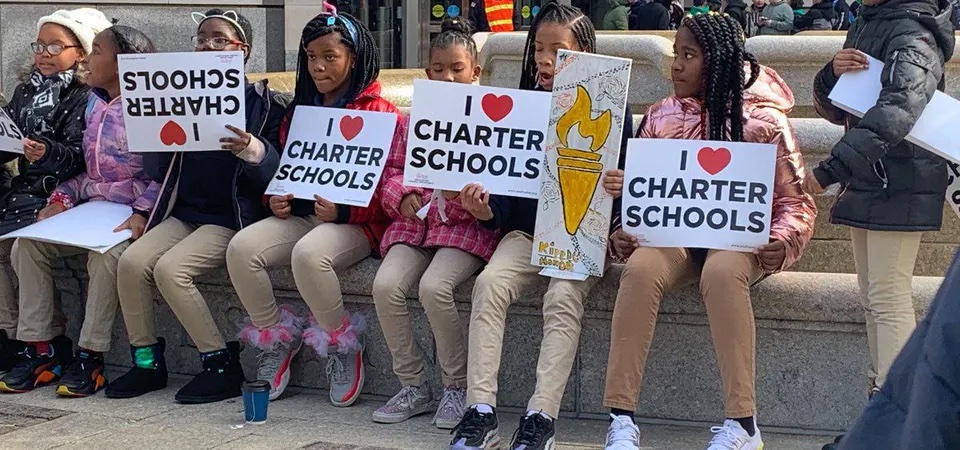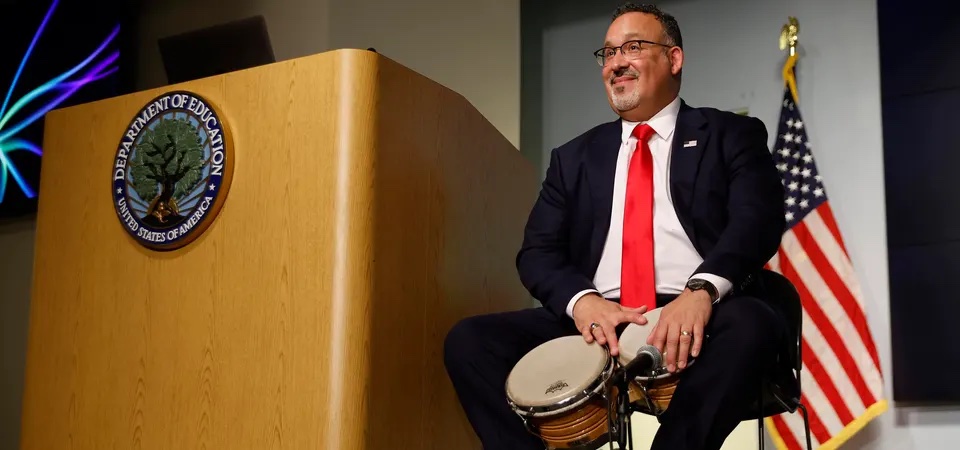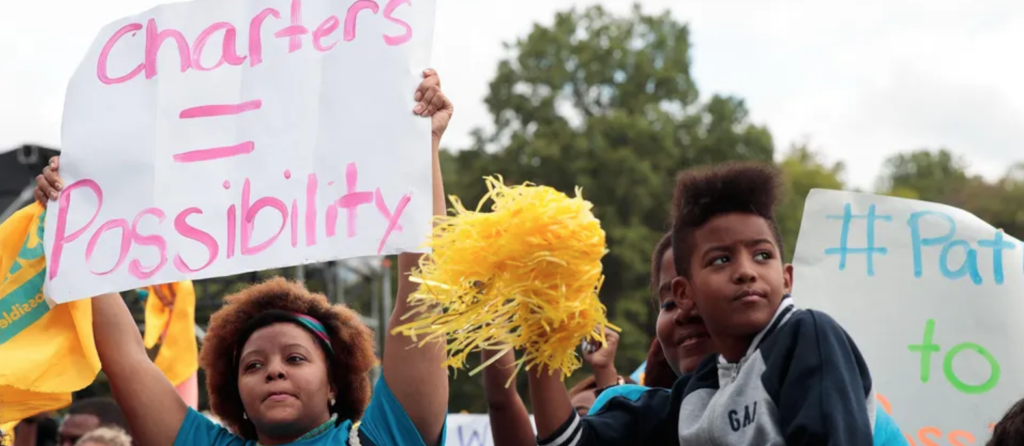

May 10, 2023

Students Rally for Charter Schools YASS PRIZEIt’s been a strange National Charter Schools Week – the week set aside by Congress to recognize and celebrate the work and promise of the nation’s charter schools. Started 23 years ago with a proclamation and a visit by President Clinton to Minnesota, the birthplace of charter schools, the annual recognition continued through the administrations of Presidents Bush, Obama, Trump, and, well…
A Break With Tradition In a mean-spirited break with the past quarter-century, the Biden administration’s Secretary of Education, Dr. Miguel A. Cardona and his political allies have not just ignored charter schools week, but done their darndest to smother the celebration – supplanting it with Teacher Appreciation Week, which earned a presidential proclamation (sans all recognition of charters).

Students Rally for Charter Schools YASS PRIZEApril 2022, Washington, D.C. – Secretary Cardona Promotes Arts Education With Musicians GETTY IMAGESAdding insult to injury, Dr. Cardona, in his pro-teacher pronouncements for the week, praised TV shows that belittle charters, while for her most recent podcast, the secretary’s ally, American Federation of Teachers (AFT) president Randi Weingarten interviewed the star of said show, Sheryl Lee Ralph, whose state senator husband is heavily backed by teacher union funds in Philadelphia and to no one’s surprise, is opposed to charter schools.
Ember Reichgott Junge, the legislator who authored Minnesota’s 1991 first-in-the-nation charter school law, says that “chartering succeeded because it was a bipartisan initiative from the middle of the political spectrum that arose from visionary citizens outside the political system.”
She’s right. But sadly, the bipartisan, grassroots reform that ischarter schools (and a movement that probably leans more left than right these days) is, for the moment at least, not quite so bipartisan and is simply being ignored by the Biden Administration.
“Why?” you might ask.
The answer: politics and the corrupting influence of teachers unions.
The American Federation of Teachers and the National Education Association spend millions of dollars lobbying state legislators to ignore charter law amendments. The unions create such division over charters that legislators feel they have no choice but to side with the unions or lose their popularity contests. And now, with union staffers currently operating key offices in the US Department of Education, the feds play an ever-larger role in meddling with charters and their ability to grow.
This is not a surprise to the nearly 7,800 charter schools in 45 states, serving 3.8 million students, who last year had to fend off an incredible case of federal overreach aimed at regulating charters, promoting unionization and generally limiting the very freedoms that created an educational ecosystem that has led to some of the most important innovations and effective approaches to education today. If you were never sure why the federal government shouldn’t control education, there’s your answer.
Test Bed for Public Education
Today chartering is recognized not only as the test bed for public education but the birthplace of education innovation. From blended and personalized learning, to engaging virtual and hybrid programs pioneered in charters, to performance-based accountability, standards mapping, adaptive learning, teacher autonomy and so much more, charters have been killing it since they first opened in 1992. And on top of that, charter schools have incentivized forward-thinking districts to improve their performance. (This is well documented by the people who monitor charters in the field and the researchers who study them.)

New York, NY, September, 2016. Students and families participate in a rally for expanded charter school opportunities. GETTY IMAGESSo why else, save politics and union influence, would a state like Connecticut try to keep approved charter schools from getting the funding needed to open? The state does have 21 charter schools but has not opened a new one since 2015 having made the approval dependent upon legislative (i.e. political) action. It’s insane. Waiting lists for charters that do exist continue to grow, and even though the state’s education department has approved four schools since 2015 (frankly, a paltry number), the state refuses to fund them. That leaves thousands of students, like Barbara Luna, at a loss..
As she told the Connecticut Mirror “I want to try a different school that’s going to be better than the one I am at. I want to go [to a new school] that is the opposite of the one I go to now.”
This political, union-imposed blockade on funding is even more galling given Connecticut’s sagging school performance. According to NAEP – the National Assessment of Educational Progress, the largest continuing and nationally representative assessment of what U.S. students know and can do in various subjects – in 2022 only 35 percent of Connecticut students performed at or above the NAEP “proficient” level, down from 2019’s less-than-stellar 41 percent. And if you parse the data, minority children fare far worse. All this in spite of Connecticut being one of the top five spenders on education. Would charter schools offer a way forward, a path to success, hope and promise for thousands of Barbara’s? Unequivocally, yes. Will the unions allow it? No.
Thankfully there are states that do give students like Barbara what they want, need and deserve. So let us celebrate them during this muted National Charter Schools Week.
Progress Against All Odds

Students from Arizona Autism Charter School YASS PRIZEArizona, for example, where freedom to operate and grow has helped create schools like Arizona Autism Charter Schools in Phoenix, which doubled its enrollment in just six years. The state’s 560-plus charters, serving 21 percent of the state’s enrollment, have blossomed since they began. But, full disclosure, for years foes, and even friends, tried to slow the growth. Thankfully reason – and parents – prevailed.
And there’s Florida, where according to the Florida Charter School Alliance “more than 361,900 students attend a public charter school, or 12.8% of the total K-12 public school enrollment in the state. If charter schools were a district, they would be the second largest school district in Florida.” The prevalence of charter schools spurred districts to create their own enterprising schools and options of parents and are responsible for forcing improvements in the long-failing Miami-Dade School District.
Ohio’s charter schools nearly died from asphyxiation when “friends” tried to choke them with some 600 rules intended to eliminate bad apples. Rather than focus on why schools failed, it was decided that only the government could solve the problem…by smothering it. Finally, entrepreneurs running some of the state’s largest schools and networks brought much needed oxygen to the patient and today 323 schools (and growing) support 119,291 students. (A personal favorite: Oakmont Education. A network of schools that provides dropout recovery and industry certifications to over 2,500 students, Oakmont provides training in the construction and manufacturing trades; in community wellness, in such areas as health care and special education; and in business and entrepreneurship in culinary arts, information technology, retail, and hospitality.
In the District of Columbia, Friendship Public Charter Schools is among the 135 schools serving 48 percent of the city’s students, (in total over 45,000 children) and would serve more if the city’s once fiercely independent charter authorizer didn’t work to prevent that from happening. Among the first African American founded charter school networks in the nation, Friendship has brought high expectations and innovative programs targeted to the youth who need it most. Friendship was one of the dozens of charters celebrated by President Barack Obama, whose administration was often at odds with teachers unions. So was the DC City Council, which now works to restrict charter funding, especially for facilities – the resource that brings charter public schools closer in parity to district public schools and a primary reason for their proliferation. It’s a brilliant political move – if you want to get rid of something, aim at its foundation. These are teachers’ union-driven antics at their best.
If the majority of the nation’s 13,000 public school districts were excelling like charter schools, it would be front page news. Most charter schools — equivalent to some 7,800 mini-districts – are creating excellence for students, and demand for these schools is high. But rather than expand these opportunities, lawmakers keep or enact caps, lower funding, and heap limits on their freedom to operate in exchange for federal funds. It makes no sense and would not be tolerated in any other issue area. But no other issue area has a union like education does.
So, for National Charter School Week 2023 let us rejoice in what has been achieved and what is sure to be future success, but also mourn what is being lost to politics, and an obstructionist union that puts its interests ahead of the rights and needs of parents and children.Follow Jeanne on Twitter or LinkedIn or some of her other work here.
Founded in 1993, the Center for Education Reform aims to expand educational opportunities that lead to improved economic outcomes for all Americans — particularly our youth — ensuring that conditions are ripe for innovation, freedom and flexibility throughout U.S. education.

